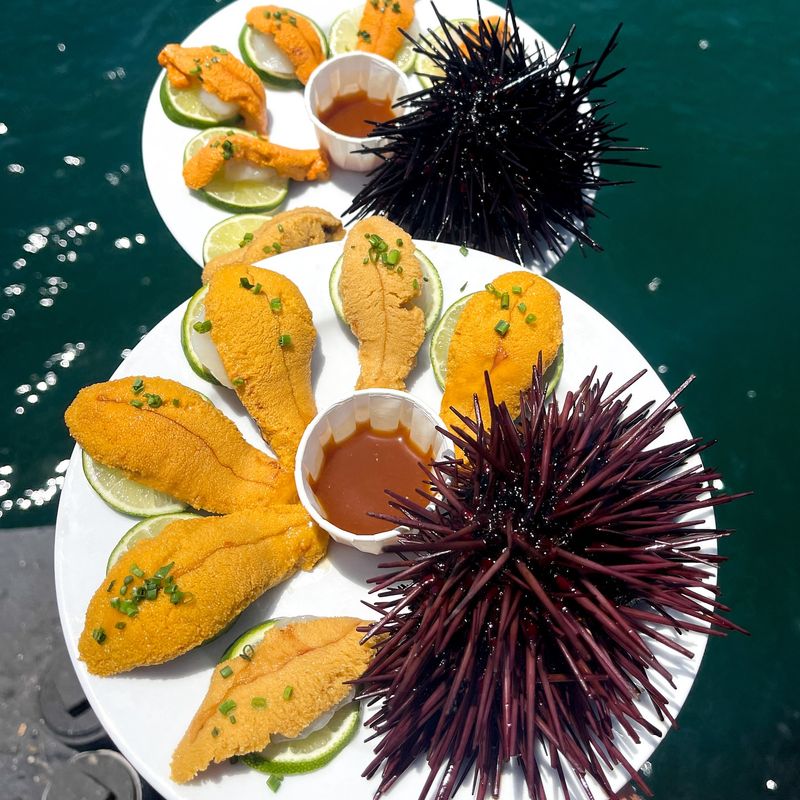Food prejudice runs deeper than we think. Many people wrinkle their noses at certain dishes without ever taking a single bite. These foods often get bad reputations from movies, stories, or just their unusual appearance. Today we’re exploring foods that might surprise you with their amazing flavors if you give them a fair chance.
1. Stinky Tofu
Street vendors across Taiwan serve this fermented delight that smells stronger than it tastes. The preparation involves weeks of careful fermentation in brine made from vegetables and sometimes dried shrimp.
Once you get past the initial aroma, stinky tofu reveals a complex, cheese-like flavor with crispy edges and silky centers. Many first-timers compare it to aged blue cheese.
Popular toppings include pickled cabbage, spicy sauce, and fresh herbs that balance the rich, umami-packed base perfectly.
2. Durian
Southeast Asia’s most controversial fruit carries a reputation that precedes its actual taste by miles. Hotels ban it, but locals consider durian the king of all fruits for good reason.
Behind that infamous smell lies custard-like flesh with notes of vanilla, almonds, and tropical sweetness. The texture resembles rich ice cream that melts on your tongue.
First-time tasters should try it fresh and cold, which mellows the aroma while highlighting the creamy, almost dessert-like qualities that make it so beloved.
3. Sea Urchin
Ocean treasures don’t get more misunderstood than these spiny creatures hiding buttery gold inside their shells. Sushi restaurants charge premium prices for uni, and there’s a reason why.
The orange roe tastes like concentrated ocean essence mixed with rich butter and subtle sweetness. Each piece melts immediately, leaving behind pure, clean seafood flavor.
Quality matters enormously with sea urchin – fresh specimens from cold waters offer completely different experiences than older, lower-grade options that might taste overly fishy.
4. Haggis
Scotland’s national dish sounds scarier than it actually tastes, especially when prepared by skilled hands. Modern versions focus more on flavor than traditional ingredients that might worry squeamish eaters.
Well-made haggis resembles seasoned ground meat with oats, creating a hearty, warming texture. Spices like black pepper, nutmeg, and herbs create complex, comforting flavors.
Pair it with creamy mashed potatoes and turnips, and you’ll understand why Scots celebrate this dish with such passion and pride every Burns Night.
5. Anchovies
Pizza controversies aside, these tiny fish pack incredible flavor when used correctly rather than straight from questionable cans. Fresh anchovies taste completely different from their preserved counterparts.
Quality anchovies dissolve into dishes, adding deep, salty richness without overwhelming fishiness. They enhance tomato sauces, salad dressings, and Mediterranean dishes with subtle complexity.
Try white anchovies marinated in vinegar and oil, or fresh ones grilled with lemon and herbs. You might discover why these little fish command such respect in professional kitchens.
6. Escargots
French bistros wouldn’t serve these garden dwellers if they didn’t taste absolutely wonderful with proper preparation. The snails themselves have very mild flavor, almost like tender clams.
Garlic butter does most of the heavy lifting here, infusing each morsel with herbs, wine, and rich, aromatic goodness. The texture resembles firm mushrooms or shellfish.
Using special forks and tiny spoons becomes part of the fun dining experience. Most people find escargot much more approachable than expected, focusing on the delicious butter sauce.
7. Blood Sausage
European breakfast tables feature this dark sausage alongside eggs and toast for good reason. The name sounds intimidating, but the actual eating experience focuses on rich, savory flavors.
Quality blood sausage tastes like well-seasoned, slightly sweet meat with hints of spices and grains. The texture stays firm but tender, similar to regular sausage.
British black pudding, Spanish morcilla, and German blutwurst each offer different spice profiles and textures. Try it fried crispy with apples or incorporated into hearty stews and pasta dishes.
8. Liver
Childhood trauma from overcooked liver shouldn’t define your adult relationship with this nutritional powerhouse. Properly prepared liver tastes rich, smooth, and surprisingly mild when not ruined by poor cooking.
Chicken liver works best for beginners, offering creamy texture and gentle flavor. Quick searing keeps it tender while caramelized onions add sweetness that balances any mineral notes.
French pâtés and Jewish chopped liver transform this ingredient into spreadable delicacies. The key lies in not overcooking and using complementary flavors like wine, herbs, or fruit.
9. Kimchi
Korean fermentation creates magic in simple cabbage, transforming ordinary vegetables into probiotic-rich flavor bombs. The fermentation process develops complex tastes impossible to achieve through regular cooking methods.
Expect tangy, spicy, garlicky flavors with satisfying crunch and subtle funk from beneficial bacteria. Each bite delivers layers of heat, sourness, and umami depth.
Start with milder versions before progressing to traditional recipes. Kimchi enhances fried rice, burgers, tacos, and countless fusion dishes while supporting digestive health through natural probiotics.
10. Caviar
Luxury food reputation creates expectations that might not match reality for first-time tasters. Real caviar offers subtle, briny flavor with delicate texture rather than overwhelming fishiness.
Each egg pops gently between your teeth, releasing clean ocean essence without heavy salt or strong fish taste. The experience focuses more on texture and mild flavor nuances.
Quality varies dramatically between grades and sources. Start with smaller portions on neutral crackers or blinis to appreciate the delicate characteristics without breaking your budget completely.
11. Okra
Southern cooking wouldn’t be complete without this misunderstood vegetable that gets blamed for texture issues caused by poor preparation. The key lies in proper cooking techniques that minimize sliminess.
Quick cooking methods like grilling, roasting, or high-heat sautéing preserve okra’s natural crunch while developing nutty, almost asparagus-like flavors. The pods taste mild and slightly sweet.
Indian bhindi, Greek bamies, and Creole gumbo all showcase okra’s versatility when handled correctly. Try it pickled, fried, or added to stews where its natural thickening properties become advantages.
12. Sweetbreads
Fine dining restaurants charge premium prices for these organ meats that taste nothing like their intimidating name suggests. Properly prepared sweetbreads offer incredibly tender, almost custard-like texture.
The flavor stays remarkably mild and creamy, similar to rich chicken or veal without any strong organ meat characteristics. Professional preparation involves careful cleaning and gentle cooking techniques.
French cuisine elevates sweetbreads with wine sauces, herbs, and careful searing that creates crispy exteriors protecting delicate centers. Many diners never realize what they’re eating until after finishing.
13. Natto
Japanese breakfast staples don’t get more polarizing than these fermented soybeans with their distinctive stringy texture. The appearance challenges Western expectations, but the nutritional benefits are undeniable.
Natto tastes nutty and slightly bitter with cheese-like complexity from fermentation. The sticky strands might seem strange initially, but they indicate successful fermentation and probiotic activity.
Mix it with rice, green onions, and soy sauce for traditional presentation. The beans provide complete protein, vitamin K2, and beneficial bacteria for digestive health.
14. Bitter Melon
Asian markets stock this warty green vegetable that lives up to its name with intense bitter flavor. However, proper preparation techniques can tame the bitterness while preserving beneficial compounds.
Salt treatment, blanching, or pairing with strong flavors helps balance the natural bitterness. The texture resembles cucumber with slightly firmer flesh and interesting bumpy skin.
Chinese stir-fries, Indian curries, and Filipino dishes incorporate bitter melon for its supposed health benefits including blood sugar regulation. Start with small amounts mixed into flavorful dishes.














Leave a comment